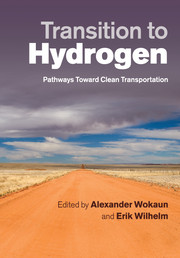Book contents
- Frontmatter
- Contents
- Contributors
- Foreword: on the transition to hydrogen
- Preface
- Executive summary
- Abbreviations
- 1 Introduction
- 2 Life cycle assessment of hydrogen production
- 3 Technical characterisation and multi-criteria analysis of light-duty vehicles
- 4 Hydrogen emissions to the atmosphere from industry and transportation
- 5 Regional fleet simulation
- 6 Long-term scenarios of the global energy and transport system
- 7 Integrated assessment of hydrogen in transportation
- Appendix A Summary of fundamental assumptions
- Appendix B Selected input assumptions, technology descriptions, and heuristics
- Appendix C Characteristics of the present and future vehicle designs
- Appendix D Survey questionnaire and aggregated responses
- Appendix E Assumptions and inputs driving fleet dynamics simulation
- References
- Index
- Plates
Foreword: on the transition to hydrogen
Published online by Cambridge University Press: 05 November 2011
- Frontmatter
- Contents
- Contributors
- Foreword: on the transition to hydrogen
- Preface
- Executive summary
- Abbreviations
- 1 Introduction
- 2 Life cycle assessment of hydrogen production
- 3 Technical characterisation and multi-criteria analysis of light-duty vehicles
- 4 Hydrogen emissions to the atmosphere from industry and transportation
- 5 Regional fleet simulation
- 6 Long-term scenarios of the global energy and transport system
- 7 Integrated assessment of hydrogen in transportation
- Appendix A Summary of fundamental assumptions
- Appendix B Selected input assumptions, technology descriptions, and heuristics
- Appendix C Characteristics of the present and future vehicle designs
- Appendix D Survey questionnaire and aggregated responses
- Appendix E Assumptions and inputs driving fleet dynamics simulation
- References
- Index
- Plates
Summary
The transition to a sustainable energy supply is one of the major challenges that humans will face during the twenty-first century. This transition is inevitable, but there are many scenarios discussed for how and when this will happen. Humans have relied on renewable energy for most of history, and will do so again, as affordable supplies of fossil fuels decline in the coming decades (or centuries). However, there is wide agreement that the world should not give up the benefits of modern technology. The transition to a ‘green’ energy supply has already begun, and technologies for collecting and converting energy from the environment, new means of energy storage, and increased energy efficiency have progressed greatly. That is why there is legitimate hope that the coming change will be possible without a major reduction in the quality of life.
Individual mobility and long-distance travel have become vital elements of human existence. This mobility and the freedom it enables are taken for granted by most, and even considered a fundamental right. Most of this mobility is provided by the more than 900 million motor vehicles that now populate roads around the globe. An enormous number – and expected to grow to more than 1.1 billion in less than a decade. If all the motor vehicles on the globe were put bumper to bumper, the resulting giant traffic jam would be 4.5 million kilometres long, or wrap around the globe more than 100 times.
- Type
- Chapter
- Information
- Transition to HydrogenPathways Toward Clean Transportation, pp. x - xiiPublisher: Cambridge University PressPrint publication year: 2011



